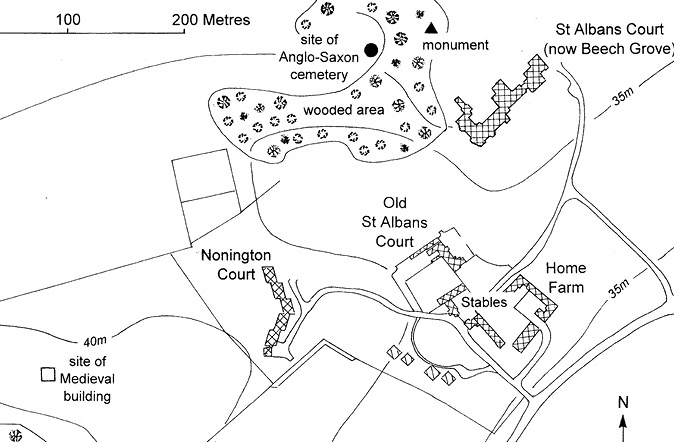Pre-historic St. Alban’s Court discoveries
During a watching brief at St. Alban’s Court in 1997 the Thanet Trust for Archaeology discovered possible Late Bronze Age, 1000-701 BC., hut circles and enclosure during the construction of an access road which is now the main entrance to the property.
The watching brief produced possible remains of pre-historic hut sites, floors and drip trench and enclosure. There was a lack of datable materials (burn daub and one pre-historic pot sherd) but hut sites reminiscent in form and state of preservation to Late Bronze Age hut circles encountered by excavator at Monkton and Ebbsfleet. Thin general scatter of pot boilers, (flints heated in the fire until extremely hot and then dropped into a vessel of liquid to heat it, pottery the of that period in time could not survive direct flame) in the area and lack of pottery may indicate a low level of occupation.
The Saxon cemetery at St. Alban’s Court, Nonington.
During October of 1875 William Oxenden Hammond ordered work done to prepare for tree planting near the new St. Alban’s Court house and during this work fifteen skeletons were discovered in shallow graves cut into the underlying chalk on an east to west alignment. There were a number of finds recovered from these graves including a blade of about 8’’ in length, and a riveted bronze ring of about 3’’ inches in diameter which was around the fore-arm of one of the skeletons. Unfortunately, the location of these grave goods is now unknown. Naturally occurring rounded flint nodules, often found locally in fields and gardens in chalk, were also present in the graves and at the time were believed to be Roman sling shot responsible for the deaths of the occupants of the graves so giving rise to a belief that a battle had been fought on or near the spot.
The skeletons were later reburied to the north east of their place of discovery under a stone pyramid with a plaque with a Latin inscription on its western face which highlights the mistaken belief in a battle involving the Romans having taken place. The inscription reads:
HOS CINERES-
BARBARA MANU NUPER ERUPTOS-
QUIBUS REQUIEM SEPILCHRI-
IMMOTAM NEQUE ADHUC TERRA CINCESSIT-
IN HOSPITIUM TUMULI RETITUIT EXTRANEUS-
AD MDCCCLXXVI-
SEU FORSAN ROMANI PRO IMPERIO CAESI-
SEU BRITANNI PRO ARIS ET FOCIS-
SIVE INTER PASCUA SAXONES POSITI-
QUALES CUNQUE-
QUATUORDECIM HIC POST TOT SAECULA-
SUPREMUM DIEM EXPECTANT.
This translates as:
“These remains- recently uprooted by a barbarian hand-
which until now the earth held firm in the sacred peace of the tomb-
a stranger has restored to the safety of this mound-
ad 1876 whether perchance Romans for Caesar’s empire whether Britons for hearth and home-
whether Saxons amongst their flocks who ever, yet after as many as fourteen centuries-
they await the judgement day”.
The discovery of the bones may have given rise to the local tale of this being the burial ground of a convent which had supposedly stood nearby in ‘The Ruins’’. This myth probably has its origins in the fact that in the eight century the old Oesewalum estate had belonged to both Minster and Lyminge convents, this connection is the most likely origin of Nonington, originally Nunningtun, the nuns farm, which was probably near to St. Mary’s Church.
Remains of a flint and stone building were clearly visible into the 1980’s, some of the walls had been high enough in the 1930’s to form part of a pig stye. However, recent research and archaeological excavations from 2009 to the present have revealed a series of fairly high status manorial buildings dating from the mid to late 1200’s to the mid-1600’s which are connected to the old Domesday Book manor of Essewelle which evolved into the Fredville and Esole [Beauchamps] manors, the later becoming part of the St. Alban’s estate in 1558.
In 2001 the Dover Archaeology Group carried out a geophysical survey and excavation of the area where the graves had been discovered as part of ongoing research by the Group into St. Alban’s Court and the Easole manor. Full details of this excavation can be found at Anglo-Saxon cemetery sites around Nonington by Keith Parfitt of the Dover Archaeological Group, 2024].



